Epogen, Procrit (epoetin alfa) dosing, indications, interactions, adverse effects, and more (original) (raw)
Dosing & Uses
AdultPediatric
Dosage Forms & Strengths
injectable solution
- 2000 units/mL (Epogen, Procrit, Retacrit)
- 3000 units/mL (Epogen, Procrit, Retacrit)
- 4000 units/mL (Epogen, Procrit, Retacrit)
- 10,000 units/mL (Epogen, Procrit, Retacrit)
- 20,000 units/mL (Epogen, Procrit, Retacrit)
- 40,000 units/mL (Retacrit)
Biosimilar to Epogen and Procrit
- Retacrit (epoetin alfa-epbx)
Chronic Kidney Disease-Associated Anemia
Epogen, Procrit, Retacrit
Reduction of need for red blood cell (RBC) transfusion in patients with chronic kidney disease (CKD) on dialysis and not on dialysis
Patients with CKD on dialysis
- Initiate treatment when hemoglobin (Hgb) level <10 g/dL
- If Hgb level approaches or >11 g/dL, reduce or interrupt dose
- 50-100 units/kg IV/SC 3 times weekly initially
Patients with CKD not on dialysis
Initiating treatment only when Hbg level is <10 g/dL and the following:
- Rate of Hgb decline indicates the likelihood of requiring a RBC transfusion
- Reducing the risk of alloimmunization and/or other RBC transfusion-related risks is a goal
- If Hgb level >10 g/dL, reduce or interrupt dose, and use the lowest dose of epoetin alfa sufficient to reduce the need for RBC transfusions
- 50-100 units/kg IV 3 times weekly initially
Zidovudine-Related Anemia
Epogen, Procrit, Retacrit
Treatment of anemia due to zidovudine administered at <4200 mg/week in HIV-infected patients with endogenous serum erythropoietin levels of <500 milliunits/mL
100 units/kg IV/SC 3 times weekly initially
If Hgb does not increase after 8 weeks, increase dose by 50-100 units/kg every 4-8 weeks until hemoglobin reaches level sufficient to avoid RBC transfusions; alternatively, administer 300 units/kg
If Hgb >12 g/dL: Withhold dose; resume therapy at a dose 25% below the previous dose when Hgb declines to <11 g/dL
If no Hgb increased is not achieved at a dose of 300 Units/kg for 8 weeks, discontinue dose
Chemotherapy-Related Anemia
Epogen, Procrit, Retacrit
Treatment of anemia in patients with nonmyeloid malignancies where anemia is due to effect of concomitant myelosuppressive chemotherapy, and upon initiation, there is a minimum of 2 additional months of planned chemotherapy
150 units/kg IV/SC 3 times weekly initially; alternatively, 40,000 units SC once weekly until completion of chemotherapy course
Reduce dose by 25%
- Hgb increases >1 g/dL in any 2-week period
- Hgb reaches a level needed to avoid RBC transfusion
- Withhold dose if hemoglobin exceeds a level needed to avoid RBC transfusion; reinitiate at a dose 25% below the previous dose when hemoglobin approaches a level where RBC transfusions may be required
Dose increase
- After initial 4 weeks of therapy, if Hgb increases by <1 g/dL and remains <10 g/dL, increase dose to 300 units/kg three times per week or 60,000 units weekly
- If no response after 8 weeks or if RBC transfusions required, discontinue dose
Reduction of Allogeneic Red Blood Cell Transfusions in Patients Undergoing Elective, Noncardiac, Nonvascular Surgery
Epogen, Procrit, Retacrit
Indicated to reduce the need for allogeneic RBC transfusions in patients with perioperative hemoglobin >10 g/dL but ≤13 g/dL who are at high risk for perioperative blood loss from elective, noncardiac, nonvascular surgery
300 units/kg SC once daily for 15 consecutive days (10 days preceding surgery, day of surgery, 4 days following surgery)
Alternatively, 600 units/kg SC in 4 doses administered 21, 14, and 7 days before surgery and on day of surgery
Concomitant deep vein thrombosis (DVT) prophylaxis is recommended
Dosing Considerations
Evaluate iron status before and during treatment, and maintain iron repletion
Correct or exclude other causes of anemia (eg, vitamin deficiency, metabolic or chronic inflammatory conditions, bleeding) before initiating therapy
Selection of formulation
- Use only single-dose vials (the benzyl alcohol-free formulation) for pregnant females, lactating females, neonates, and infants
CKD-associated anemia
- When initiating or adjusting therapy, monitor Hgb levels at least weekly until stable, then at least monthly
- Consider rate of hemoglobin rise or decline, responsiveness to erythropoiesis-stimulating agents (ESAs), and hemoglobin variability
- Do not increase the dose more frequently than q4weeks
- Decreases in dose can occur more frequently; avoid frequent dose adjustment
- If hemoglobin rises rapidly (eg, >1 g/dL in any 2-week period), reduce dose by ≥25% as needed to reduce rapid responses; may reduce dose more frequently than once q4weeks; avoid frequent dose adjustments
- Inadequate response (eg, if Hgb does not increase by >1 g/dL after 4 weeks of therapy): Increase dose by 25%; if inadequate response over 12-week escalation period, further dose increase is unlikely to improve response and may increase risks
- Individualize dosing, and use lowest dose that will maintain hemoglobin level sufficient to reduce need for RBC transfusions; discontinue if responsiveness does not improve
Limitations of use
- Not shown to improve quality of life, fatigue, or patient well-being
Not indicated for use
- Patients with cancer receiving hormonal agents, biologic products, or radiotherapy, unless also receiving concomitant myelosuppressive chemotherapy
- Patients with cancer receiving myelosuppressive chemotherapy when the anticipated outcome is cure
- Patients with cancer receiving myelosuppressive chemotherapy in whom the anemia can be managed by transfusion
- Patients scheduled for surgery who are willing to donate autologous blood
- Patients undergoing cardiac or vascular surgery
- As a substitute for RBC transfusions in patients who require immediate correction of anemia
Dosage Forms & Strengths
injectable solution
- 2000 units/mL (Epogen, Procrit, Retacrit)
- 3000 units/mL (Epogen, Procrit, Retacrit)
- 4000 units/mL (Epogen, Procrit, Retacrit)
- 10,000 units/mL (Epogen, Procrit, Retacrit)
- 20,000 units/mL (Epogen, Procrit, Retacrit)
- 40,000 units/mL (Retacrit)
Biosimilar to Epogen and Procrit
- Retacrit (epoetin alfa-epbx)
Chronic Kidney Disease-Associated Anemia
Epogen, Procrit, Retacrit
Indicated to reduce the need for red blood cell (RBC) transfusion in patients with chronic kidney disease (CKD)
<1 month: Safety and efficacy not established
>1 month: 50 units/kg IV/SC 3 times weekly initially; if patient on dialysis, IV route recommended
Initiate when hemoglobin level <10 g/dL; if hemoglobin level approaches or exceeds 11 g/dL, reduce or interrupt dose
Zidovudine-Related Anemia
Epogen, Procrit, Retacrit
Published literature reported the use of epoetin alfa in 20 zidovudine-treated, anemic, pediatric patients with HIV infection
<8 months: Safety and efficacy not established
8 months-17 years: 50-400 units/kg SC/IV 2-3 times weekly
Chemotherapy-Related Anemia
Epogen, Procrit, Retacrit
Treatment of anemia in patients with nonmyeloid malignancies where anemia is due to effect of concomitant myelosuppressive chemotherapy, and upon initiation, there is a minimum of 2 additional months of planned chemotherapy
<5 years: Safety and efficacy not established
5-18 years: 600 units/kg IV once weekly; not to exceed 40,000 units
Reduce dose by 25%
- Hgb increases >1 g/dL in any 2-week period
- Hgb reaches a level needed to avoid RBC transfusion
- Withhold dose if hemoglobin exceeds a level needed to avoid RBC transfusion; reinitiate at a dose 25% below the previous dose when hemoglobin approaches a level where RBC transfusions may be required
Dose increase
- After initial 4 weeks of therapy, if Hgb increases by <1 g/dL and remains <10 g/dL, increase dose to: 900 Units/kg (not to exceed 60,000 Units/dose) weekly
- If no response after 8 weeks or if RBC transfusions required, discontinue dose
Dosing Considerations
Evaluate iron status before and during treatment, and maintain iron repletion
Correct or exclude other causes of anemia (eg, vitamin deficiency, metabolic or chronic inflammatory conditions, bleeding) before initiating therapy
Selection of formulation
- Use only single-dose vials (the benzyl alcohol-free formulation) for pregnant females, lactating females, neonates, and infants
CKD-associated anemia
- When initiating or adjusting therapy, monitor Hgb levels at least weekly until stable, then at least monthly
- Consider rate of hemoglobin rise or decline, responsiveness to erythropoiesis-stimulating agents (ESAs), and hemoglobin variability
- Do not increase the dose more frequently than q4weeks
- Decreases in dose can occur more frequently; avoid frequent dose adjustment
- If hemoglobin rises rapidly (eg, >1 g/dL in any 2-week period), reduce dose by ≥25% as needed to reduce rapid responses; may reduce dose more frequently than once q4weeks; avoid frequent dose adjustments
- Inadequate response (eg, if Hgb does not increase by >1 g/dL after 4 weeks of therapy): Increase dose by 25%; if inadequate response over 12-week escalation period, further dose increase is unlikely to improve response and may increase risks
- Individualize dosing, and use lowest dose that will maintain hemoglobin level sufficient to reduce need for RBC transfusions; discontinue if responsiveness does not improve
Limitations of use
- Not shown to improve quality of life, fatigue, or patient well-being
Not indicated for use
- Patients with cancer receiving hormonal agents, biologic products, or radiotherapy, unless also receiving concomitant myelosuppressive chemotherapy
- Patients with cancer receiving myelosuppressive chemotherapy when the anticipated outcome is cure
- Patients with cancer receiving myelosuppressive chemotherapy in whom the anemia can be managed by transfusion
- Patients scheduled for surgery who are willing to donate autologous blood Patients undergoing cardiac or vascular surgery
- As a substitute for RBC transfusions in patients who require immediate correction of anemia
Interactions
Interaction Checker
Enter a drug name to check for any interactions. + epoetin alfa

No Interactions Found
Interactions Found
Contraindicated
Serious
Significant - Monitor Closely
Minor
All Interactions Sort By:

Contraindicated (0)
Serious (1)
- exagamglogene autotemcel
epoetin alfa, exagamglogene autotemcel. Other (see comment). Avoid or Use Alternate Drug. Comment: Granulocyte-colony stimulating factor (G-CSF) must not be used for CD34+ HSC mobilization of patients with sickle cell disease. .
Monitor Closely (3)
- cyclosporine
epoetin alfa, cyclosporine. Other (see comment). Use Caution/Monitor. Comment: Cyclosporine may potentiate hypertensive effects with erythropoiesis-stimulating agents (ESAs). Additionally, use of ESAs may alter cyclosporine blood levels, since cyclosporine is bound by red blood cells. - dichlorphenamide
dichlorphenamide and epoetin alfa both decrease serum potassium. Use Caution/Monitor. - methyltestosterone
methyltestosterone increases effects of epoetin alfa by pharmacodynamic synergism. Use Caution/Monitor. Concurrent administration of androgens can increase the patient's response to epoetin alfa, reducing the amount required to treat anemia. Because of potential adverse effects drug combination should be avoided.
Minor (7)
danazol
danazol increases effects of epoetin alfa by pharmacodynamic synergism. Minor/Significance Unknown. Androgens may be used to decrease necessary dose of epoetin alfa.fluoxymesterone
fluoxymesterone increases effects of epoetin alfa by pharmacodynamic synergism. Minor/Significance Unknown. Androgens may be used to decrease necessary dose of epoetin alfa.oxandrolone
oxandrolone increases effects of epoetin alfa by pharmacodynamic synergism. Minor/Significance Unknown. Androgens may be used to decrease necessary dose of epoetin alfa.oxymetholone
oxymetholone increases effects of epoetin alfa by pharmacodynamic synergism. Minor/Significance Unknown. Androgens may be used to decrease necessary dose of epoetin alfa.testosterone
testosterone increases effects of epoetin alfa by pharmacodynamic synergism. Minor/Significance Unknown. Androgens may be used to decrease necessary dose of epoetin alfa.testosterone buccal system
testosterone buccal system increases effects of epoetin alfa by pharmacodynamic synergism. Minor/Significance Unknown. Androgens may be used to decrease necessary dose of epoetin alfa.testosterone topical
testosterone topical increases effects of epoetin alfa by pharmacodynamic synergism. Minor/Significance Unknown. Androgens may be used to decrease necessary dose of epoetin alfa.cyclosporine
Monitor Closely (1)epoetin alfa, cyclosporine. Other (see comment). Use Caution/Monitor. Comment: Cyclosporine may potentiate hypertensive effects with erythropoiesis-stimulating agents (ESAs). Additionally, use of ESAs may alter cyclosporine blood levels, since cyclosporine is bound by red blood cells.danazol
Minor (1)danazol increases effects of epoetin alfa by pharmacodynamic synergism. Minor/Significance Unknown. Androgens may be used to decrease necessary dose of epoetin alfa.dichlorphenamide
Monitor Closely (1)dichlorphenamide and epoetin alfa both decrease serum potassium. Use Caution/Monitor.exagamglogene autotemcel
Serious - Use Alternative (1)epoetin alfa, exagamglogene autotemcel. Other (see comment). Avoid or Use Alternate Drug. Comment: Granulocyte-colony stimulating factor (G-CSF) must not be used for CD34+ HSC mobilization of patients with sickle cell disease. .fluoxymesterone
Minor (1)fluoxymesterone increases effects of epoetin alfa by pharmacodynamic synergism. Minor/Significance Unknown. Androgens may be used to decrease necessary dose of epoetin alfa.methyltestosterone
Monitor Closely (1)methyltestosterone increases effects of epoetin alfa by pharmacodynamic synergism. Use Caution/Monitor. Concurrent administration of androgens can increase the patient's response to epoetin alfa, reducing the amount required to treat anemia. Because of potential adverse effects drug combination should be avoided.oxandrolone
Minor (1)oxandrolone increases effects of epoetin alfa by pharmacodynamic synergism. Minor/Significance Unknown. Androgens may be used to decrease necessary dose of epoetin alfa.oxymetholone
Minor (1)oxymetholone increases effects of epoetin alfa by pharmacodynamic synergism. Minor/Significance Unknown. Androgens may be used to decrease necessary dose of epoetin alfa.testosterone
Minor (1)testosterone increases effects of epoetin alfa by pharmacodynamic synergism. Minor/Significance Unknown. Androgens may be used to decrease necessary dose of epoetin alfa.testosterone buccal system
Minor (1)testosterone buccal system increases effects of epoetin alfa by pharmacodynamic synergism. Minor/Significance Unknown. Androgens may be used to decrease necessary dose of epoetin alfa.testosterone topical
Minor (1)testosterone topical increases effects of epoetin alfa by pharmacodynamic synergism. Minor/Significance Unknown. Androgens may be used to decrease necessary dose of epoetin alfa.
Adverse Effects
>10%
Pyrexia (10-42%)
Nausea (11-35%)
Hypertension (14-27%)
Cough (4-26%)
Vomiting (12-28%)
Pruritus (12-21%)
Rash (2-19%)
Headache (5-18%)
Arthralgias (10-16%)
1-10%
Arthralgia (10%)
Myalgia (10%)
Stomatitis (10%)
Diarrhea (9%)
Dizziness (9%)
Edema (9%)
Fatigue (9%)
Weight decrease (9%)
Medical device malfunction (artificial kidney clotting during dialysis) (8%)
Vascular occlusion (vascular access thrombosis) (8%)
Vomiting (8%)
Asthenia (7%)
Chest pain (7%)
Injection-site irritation (7%)
Muscle spasm (7%)
Upper respiratory tract infection (URTI) (7%)
Urticaria (3%)
Seizures (2.5%)
Pulmonary embolism (1%)
Respiratory tract congestion (1%)
Postmarketing Reports
Seizures
Pure red-cell aplasia
Serious allergic reactions
Injection-site reactions (eg, irritation, pain)
Porphyria
Severe cutaneous reactions
Warnings
Black Box Warnings
Chronic kidney disease
- In controlled trials, CKD patients were at greater risk for death, serious adverse cardiovascular reactions, and stroke when receiving ESA therapy to target hemoglobin level of >11 g/dL
- No trial has identified Hgb target level, ESA dose, or dosing strategy that does not increase these risks
- Use lowest dose sufficient to reduce need for RBC transfusions
Cancer
- In clinical studies, ESAs shortened overall survival or increased risk of tumor progression in patients with breast, head, and neck cancers; lymphoid; non-small cell lung cancers; and cervical cancers
- To prescribe or dispense ESAs to cancer patients, prescribers and hospitals must enroll in and comply with ESA APPRISE Oncology Program
- Use lowest dose sufficient to avoid RBC transfusions
- Use ESAs only for anemia from myelosuppressive chemotherapy; ESAs are not indicated for patients receiving myelosuppressive chemotherapy when anticipated outcome is cure
- Discontinue after completion of chemotherapy course
Perisurgery
- Due to increased risk of deep venous thrombosis (DVT), DVT prophylaxis is recommended
Contraindications
Hypersensitivity to epoetin alfa or albumin or mammalian cell-derived products
Cancer patients whose anemia is caused by factors other than chemotherapy
Uncontrolled hypertension
Pure red-cell aplasia that begins after treatment with any erythropoietin protein drugs
Use of multidose vials containing benzyl alcohol in neonates, infants, or pregnant or nursing females
Cautions
Increased incidence of death, myocardial infarction (MI), stroke, and thromboembolism: Using ESAs to target hemoglobin level of >11 g/dL increases risk of serious adverse cardiovascular reactions and has not been shown to provide additional benefit (see Black Box Warnings)
ESAs resulted in decreased locoregional control/progression-free survival (PFS) and/or overall survival
Use caution in hypertension, iron deficiency, folate or B12 deficiency, congestive heart failure (CHF), coronary artery disease (CAD), seizure disorder, sickle-cell disease, hemolytic anemia, porphyria, hematologic disorders
Cancer patients: Increased tumor progression rate when dosed to achieve hemoglobin level of >12 mg/dL
Chronic renal failure: At initiation of therapy, transferrin saturation should be ≥20% and ferritin ≥100 ng/mL
Patients undergoing surgery are at increased risk for DVT; concomitant DVT prophylaxis is strongly recommended
Epogen multidose formulations contain benzyl alcohol, which is associated with potentially fatal "gasping syndrome" in premature neonates
Zidovudine-treated patients may show response only when zidovudine dosage <4200 mg/wk and endogenous epoetin <500 U/mL
To prescribe or dispense to patients with cancer and anemia due to myelosuppressive chemotherapy, prescribers and hospitals must enroll in and comply with ESA APPRISE Oncology Program
Increased risk of seizures during first 90 days of therapy in CKD; monitor closely
Dialysis patients: IV administration recommended to reduce red-cell aplasia risk; increased anticoagulation with heparin may be required to prevent clotting of extracorporeal circuit during hemodialysis
Do not increase dose more frequently than once monthly
Contains albumin; may carry extremely remote risk for transmission or viral diseases or Creutzfeldt-Jakob disease
Blistering and skin exfoliation reactions including erythema multiforme and Stevens-Johnson syndrome (SJS)/ toxic epidermal necrolysis (TEN), reported in the postmarketing setting; discontinue therapy immediately if severe cutaneous reaction, such as SJS/TEN, is suspected
Cases of PRCA and of severe anemia, with or without other cytopenias that arise following the development of neutralizing antibodies to erythropoietin reported in patients treated with epoetin alfa
Retacrit only
- Each 1 mL single-dose vial of 2,000, 3,000, 4,000, 10,000, 40,000 Units of epoetin-alfa-epbx injection contains 0.5 mg of phenylalanine
- Before prescribing Retacrit to a patient with PKU, consider the combined daily amount of phenylalanine from all sources
Pregnancy & Lactation
Pregnancy
Limited data available on epoetin alfa use in pregnant women are insufficient to determine a drug-associated risk of adverse developmental outcomes
Multiple-dose vials contain benzyl alcohol and are contraindicated in pregnant women; there is potential for similar risks to fetuses exposed to benzyl alcohol in utero; when therapy needed during pregnancy, use a benzyl alcohol-free formulation (ie, single-dose vial); do not mix with bacteriostatic saline when administering to pregnant women because it contains benzyl alcohol
Animal data
- In animal reproductive and developmental toxicity studies, adverse fetal effects including embryo-fetal death, skeletal anomalies, and growth defects occurred when pregnant rats received epoetin alfa at doses approximating the clinical recommended starting doses
- Consider the benefits and risks of epoetin alfa for the mother and possible risks to the fetus when prescribing epoetin alfa to a pregnant woman
Lactation
There is no information regarding the presence of epoetin alfa products in human milk, the effects on the breastfed infant, or the effects on milk production
However, endogenous erythropoietin is present in human milk
Because many drugs are present in human milk, exercise caution when epoetin alfa is administered to a lactating woman
Multiple-dose vials contain benzyl alcohol and are contraindicated in lactating women; advise a lactating woman not to breastfeed for at least 2 weeks after last dose; preservative benzyl alcohol has been associated with serious adverse reactions and death when administered intravenously to neonates and infants; there is a potential for similar risks to infants exposed to benzyl alcohol through human milk
Pregnancy Categories
A: Generally acceptable. Controlled studies in pregnant women show no evidence of fetal risk.
B: May be acceptable. Either animal studies show no risk but human studies not available or animal studies showed minor risks and human studies done and showed no risk.
C: Use with caution if benefits outweigh risks. Animal studies show risk and human studies not available or neither animal nor human studies done.
D: Use in LIFE-THREATENING emergencies when no safer drug available. Positive evidence of human fetal risk.
X: Do not use in pregnancy. Risks involved outweigh potential benefits. Safer alternatives exist.
NA: Information not available.
Pharmacology
Mechanism of Action
Recombinant human erythropoietin; stimulates erythropoiesis via division and differentiation of progenitor cells in bone marrow
Absorption
Onset: Several days
Peak effects: 2-6 weeks
Peak serum time: 5-24 hr (SC)
Distribution
Vd: 9L
Bioavailability: 21-31% (SC); 3% (intraperitoneal)
Elimination
Half-life,CKD: 4-13 hr (IV)
Clearance: 14 mL/min
Excretion: Feces (majority); urine (small amounts)
Administration
IV Incompatibilities
Solution: D10W
IV Preparation
For minimal dilution, mix with bacteriostatic NS containing 20 mL NS and benzyl alcohol as bacteriostatic agent in 1:1 ratio
IV Administration
Do not administer vials admixed with bacteriostatic saline containing benzyl alcohol to pregnant females, lactating females, neonates, or infants
Single-dose vial: pH 6.6-7.2
Multidose vial: pH 5.8-6.4
Administer by direct injection without dilution
Do not mix with other drugs
Do not shake
Drug may be given via venous return line of dialysis tubing after dialysis to eliminate need for additional IV access
Storage
Unused vials
- Refrigerate at 2-8ºC (36-46ºF)
- Vials are stable for 2 weeks at room temperature
- Do not freeze or shake
- Protect vials from light
Open vials
- Refrigerate at 2-8ºC (36-46ºF)
- Discard unused portions in preservative-free vials; do not re-enter preservative-free vials
- Vials are stable for 2 weeks at room temperature; discard 21 days after initial entry
- Do not freeze or shake
- Protect vials from light
Images

| BRAND | FORM. | UNIT PRICE | PILL IMAGE |
|---|---|---|---|
| Epogen injection- | 20,000 unit/2 mL vial |  |
|
| Epogen injection- | 4,000 unit/mL vial | 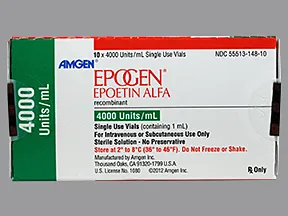 |
|
| Epogen injection- | 10,000 unit/mL vial | 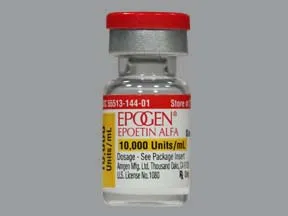 |
|
| Epogen injection- | 2,000 unit/mL vial | 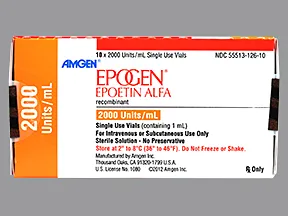 |
|
| Epogen injection- | 20,000 unit/mL vial | 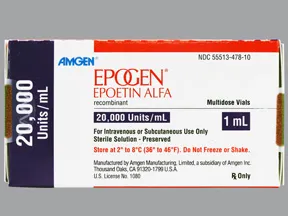 |
|
| Epogen injection- | 10,000 unit/mL vial | 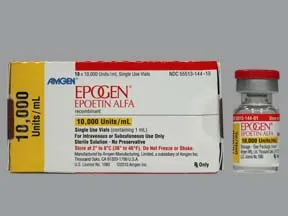 |
|
| Epogen injection- | 3,000 unit/mL vial |  |
|
| Epogen injection- | 3,000 unit/mL vial | 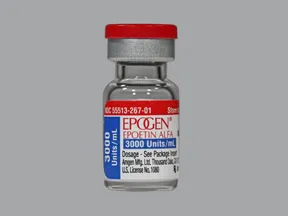 |
|
| Procrit injection- | 20,000 unit/2 mL vial | 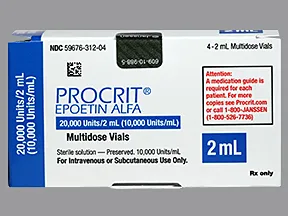 |
|
| Procrit injection- | 10,000 unit/mL vial | 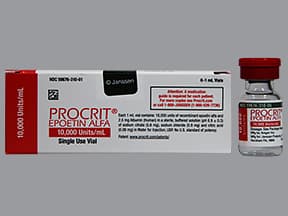 |
|
| Procrit injection- | 10,000 unit/mL vial |  |
|
| Procrit injection- | 20,000 unit/mL vial |  |
|
| Procrit injection- | 3,000 unit/mL vial | 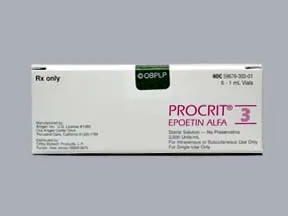 |
|
| Procrit injection- | 40,000 unit/mL vial |  |
|
| Procrit injection- | 10,000 unit/mL vial | 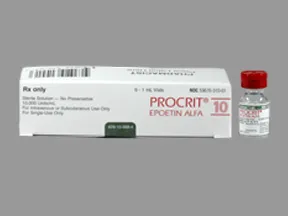 |
|
| Procrit injection- | 4,000 unit/mL vial | 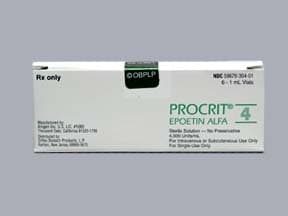 |
|
| Procrit injection- | 2,000 unit/mL vial |  |
Copyright © 2010 First DataBank, Inc.
Patient Handout


EPOETIN ALFA - INJECTION
(e-POE-tin AL-fa)
COMMON BRAND NAME(S): Epogen, Procrit, Retacrit
WARNING: Discuss the risks and benefits of epoetin alfa with your doctor, as this medication may rarely cause very serious (possibly fatal) side effects, including blood clots, heart attack, stroke, or heart failure. It is very important to keep all lab appointments since your doctor will need to carefully check your red blood cell count and hemoglobin level. The lowest effective dose of this medication should be used.When used to treat anemia related to cancer, this medication may also increase the risk of death and/or cause your tumor to grow faster. This medication should be stopped after completing a treatment course of chemotherapy as directed by your doctor.
USES: This medication is used to treat anemia (low red blood cell count) in people with long-term serious kidney disease (chronic kidney failure), people receiving zidovudine to treat HIV, and people receiving chemotherapy for some types of cancer (cancer that does not involve the bone marrow or blood cells). It may also be used in anemic patients to reduce the need for blood transfusions before certain planned surgeries that have a high risk of blood loss (usually given with an anticoagulant/"blood thinner" medication such as warfarin to lower the risk of serious blood clots). Epoetin alfa works by signaling the bone marrow to make more red blood cells. This medication is very similar to the natural substance in your body (erythropoietin) that prevents anemia.This monograph is about the following epoetin alfa products: epoetin alfa and epoetin alfa-epbx.
HOW TO USE: Read the Medication Guide and, if available, the Instructions for Use provided by your pharmacist before you start using this medication and each time you get a refill. If you have any questions, ask your doctor or pharmacist.This medication is given as an injection under the skin or into a vein as directed by your doctor, usually 1 to 3 times a week. Patients getting this medication before surgery may have a special dosing schedule. Hemodialysis patients should receive this medication by injection into a vein. If injecting this medication under the skin, the injection is given in the upper arms, abdomen, front of the middle thighs, or upper outer area of the buttocks. The dosage is based on your medical condition, weight, labs, and response to treatment.If you are using this medication at home, learn all preparation and usage instructions from your health care professional. Do not shake this medication. Before using, check this product for particles or discoloration. If either is present, do not use the liquid. If you are injecting this medication under the skin, before each dose, clean the skin you are going to inject into (the injection site) with rubbing alcohol. Change the injection site each time to lessen injury under the skin. Do not inject into skin that is tender, red, bruised, hard, or has scars or stretch marks. To lessen bruising, do not rub the injection site after a shot. Learn how to store and discard medical supplies safely.Use this medication regularly to get the most benefit from it. To help you remember, use it on the same day(s) of the week as directed.Do not increase your dose or use this drug more often or for longer than prescribed. Your condition will not improve any faster, and your risk of side effects will increase.It may take 2 to 6 weeks before your red blood cell count increases. Tell your doctor if your symptoms do not get better or if they get worse.
SIDE EFFECTS: Headache, body aches, cough, or injection site irritation/pain may occur. If any of these effects last or get worse, tell your doctor or pharmacist promptly.Remember that this medication has been prescribed because your doctor has judged that the benefit to you is greater than the risk of side effects. Many people using this medication do not have serious side effects.Epoetin alfa may sometimes cause or worsen high blood pressure, especially in patients with long-term kidney failure. This effect may be caused by the number of red blood cells increasing too quickly, usually within the first 3 months of starting treatment. If you have high blood pressure, it should be well controlled before beginning treatment with this medication. Your blood pressure should be checked often. Ask your doctor if you should learn how to check your own blood pressure. If high blood pressure develops or worsens, follow your doctor's instructions about diet changes and starting or adjusting your high blood pressure medication. Lowering high blood pressure helps prevent strokes, heart attacks, and further kidney problems. Keep all lab appointments to have your red blood cell count/hemoglobin level tested regularly to reduce the chance of this side effect.Rarely, this medication may suddenly stop working well after a period of time because your body may make antibodies to it. A very serious anemia can result. Tell your doctor right away if symptoms of anemia return (such as increased tiredness, low energy, pale skin color, shortness of breath).Tell your doctor right away if you have any serious side effects, including: symptoms of heart failure (such as shortness of breath, swelling ankles/feet, unusual tiredness, unusual/sudden weight gain).Get medical help right away if you have any very serious side effects, including: seizures.This medication may rarely cause serious (sometimes fatal) problems from blood clots (such as heart attack, stroke, blood clots in the lungs or legs). You may be at increased risk for blood clots if you are severely dehydrated, or have a history of blood clots, heart/blood vessel disease, heart failure, stroke, pregnant, or if you are immobile (such as on very long plane flights or being bedridden). If you use estrogen-containing products, these may also increase your risk. Before using this medication, if you have any of these conditions report them to your doctor or pharmacist. Get medical help right away if any of these side effects occur: shortness of breath/rapid breathing, chest/jaw/left arm pain, unusual sweating, confusion, sudden dizziness/fainting, pain/swelling/warmth in the groin/calf, sudden/severe headaches, trouble speaking, weakness on one side of the body, sudden vision changes, blood clots in your hemodialysis vascular access site.A very serious allergic reaction to this drug is rare. However, get medical help right away if you notice any symptoms of a serious allergic reaction, including: rash, itching/swelling (especially of the face/tongue/throat), severe dizziness, trouble breathing.This is not a complete list of possible side effects. If you notice other effects not listed above, contact your doctor or pharmacist.In the US -Call your doctor for medical advice about side effects. You may report side effects to FDA at 1-800-FDA-1088 or at www.fda.gov/medwatch.In Canada - Call your doctor for medical advice about side effects. You may report side effects to Health Canada at 1-866-234-2345.
PRECAUTIONS: Before using epoetin alfa, tell your doctor or pharmacist if you are allergic to it; or to any epoetin alfa products; or to other drugs that cause more red blood cells to be made (such as darbepoetin alfa); or if you have any other allergies. This product may contain inactive ingredients (such as benzyl alcohol), which can cause allergic reactions or other problems. Talk to your pharmacist for more details.Before using this medication, tell your doctor or pharmacist your medical history, especially of: high blood pressure, heart disease (such as heart failure, past heart attack/stroke), seizure disorder, severe anemia caused by antibodies to past erythropoietin-type treatment (pure red cell aplasia).Some forms of this medication are made from human blood. Even though the blood is carefully tested, and this medication goes through a special manufacturing process, there is an extremely small chance that you may get infections from the medication (for example, viruses such as hepatitis). Consult your doctor or pharmacist for more information.This medication may contain phenylalanine. If you have phenylketonuria (PKU) or any other condition that requires you to limit/avoid phenylalanine (or aspartame) in your diet, ask your doctor or pharmacist about using this medication safely.Before having surgery, tell your doctor or dentist about all the products you use (including prescription drugs, nonprescription drugs, and herbal products).During pregnancy, this medication should be used only when clearly needed. Discuss the risks and benefits with your doctor.It is unknown if this medication passes into breast milk. Consult your doctor before breastfeeding.
DRUG INTERACTIONS: Drug interactions may change how your medications work or increase your risk for serious side effects. This document does not contain all possible drug interactions. Keep a list of all the products you use (including prescription/nonprescription drugs and herbal products) and share it with your doctor and pharmacist. Do not start, stop, or change the dosage of any medicines without your doctor's approval.
OVERDOSE: If someone has overdosed and has serious symptoms such as passing out or trouble breathing, call 911. Otherwise, call a poison control center right away. US residents can call 1-800-222-1222. Canada residents can call 1-844-764-7669.
NOTES: Do not share this medication with others.Lab and/or medical tests (such as blood pressure, complete blood count that includes hemoglobin level) should be done while you are using this medication. Keep all medical and lab appointments. Consult your doctor for more details.Blood tests for your iron levels will also be done and you may be prescribed iron supplements to take. Your doctor may recommend that you eat a well-balanced diet rich in iron (such as raisins, figs, meat, eggs, vegetables, iron-fortified cereals). Follow your doctor's instructions and dietary recommendations.
MISSED DOSE: If you miss a dose, ask your doctor or pharmacist right away for a new dosing schedule. Do not double the dose to catch up.
STORAGE: Store in the refrigerator. Do not freeze. Keep the medication in the original carton to protect from light. For the single-use vials, discard any unused medication right away. For the multi-use vials, store opened vials in the refrigerator and discard any unused medication after 3 weeks. Keep all medications away from children and pets.Do not flush medications down the toilet or pour them into a drain unless instructed to do so. Properly discard this product when it is expired or no longer needed. Consult your pharmacist or local waste disposal company.
Information last revised October 2024. Copyright(c) 2024 First Databank, Inc.
IMPORTANT: HOW TO USE THIS INFORMATION: This is a summary and does NOT have all possible information about this product. This information does not assure that this product is safe, effective, or appropriate for you. This information is not individual medical advice and does not substitute for the advice of your health care professional. Always ask your health care professional for complete information about this product and your specific health needs.
Formulary
FormularyPatient Discounts
Adding plans allows you to compare formulary status to other drugs in the same class.
To view formulary information first create a list of plans. Your list will be saved and can be edited at any time.
Adding plans allows you to:
- View the formulary and any restrictions for each plan.
- Manage and view all your plans together – even plans in different states.
- Compare formulary status to other drugs in the same class.
- Access your plan list on any device – mobile or desktop.
The above information is provided for general informational and educational purposes only. Individual plans may vary and formulary information changes. Contact the applicable plan provider for the most current information.
View explanations for tiers and restrictions
| Tier | Description |
|---|---|
| 1 | This drug is available at the lowest co-pay. Most commonly, these are generic drugs. |
| 2 | This drug is available at a middle level co-pay. Most commonly, these are "preferred" (on formulary) brand drugs. |
| 3 | This drug is available at a higher level co-pay. Most commonly, these are "non-preferred" brand drugs. |
| 4 | This drug is available at a higher level co-pay. Most commonly, these are "non-preferred" brand drugs or specialty prescription products. |
| 5 | This drug is available at a higher level co-pay. Most commonly, these are "non-preferred" brand drugs or specialty prescription products. |
| 6 | This drug is available at a higher level co-pay. Most commonly, these are "non-preferred" brand drugs or specialty prescription products. |
| NC | NOT COVERED – Drugs that are not covered by the plan. |
| Code | Definition |
|---|---|
| PA | Prior Authorization Drugs that require prior authorization. This restriction requires that specific clinical criteria be met prior to the approval of the prescription. |
| QL | Quantity Limits Drugs that have quantity limits associated with each prescription. This restriction typically limits the quantity of the drug that will be covered. |
| ST | Step Therapy Drugs that have step therapy associated with each prescription. This restriction typically requires that certain criteria be met prior to approval for the prescription. |
| OR | Other Restrictions Drugs that have restrictions other than prior authorization, quantity limits, and step therapy associated with each prescription. |
Non-Medicare Plans Medicare Plans
From:
To:
The recipient will receive more details and instructions to access this offer.
By clicking send, you acknowledge that you have permission to email the recipient with this information.
From:
To:
The recipient will receive more details and instructions to access this offer.
By clicking send, you acknowledge that you have permission to email the recipient with this information.
Medscape prescription drug monographs are based on FDA-approved labeling information, unless otherwise noted, combined with additional data derived from primary medical literature.